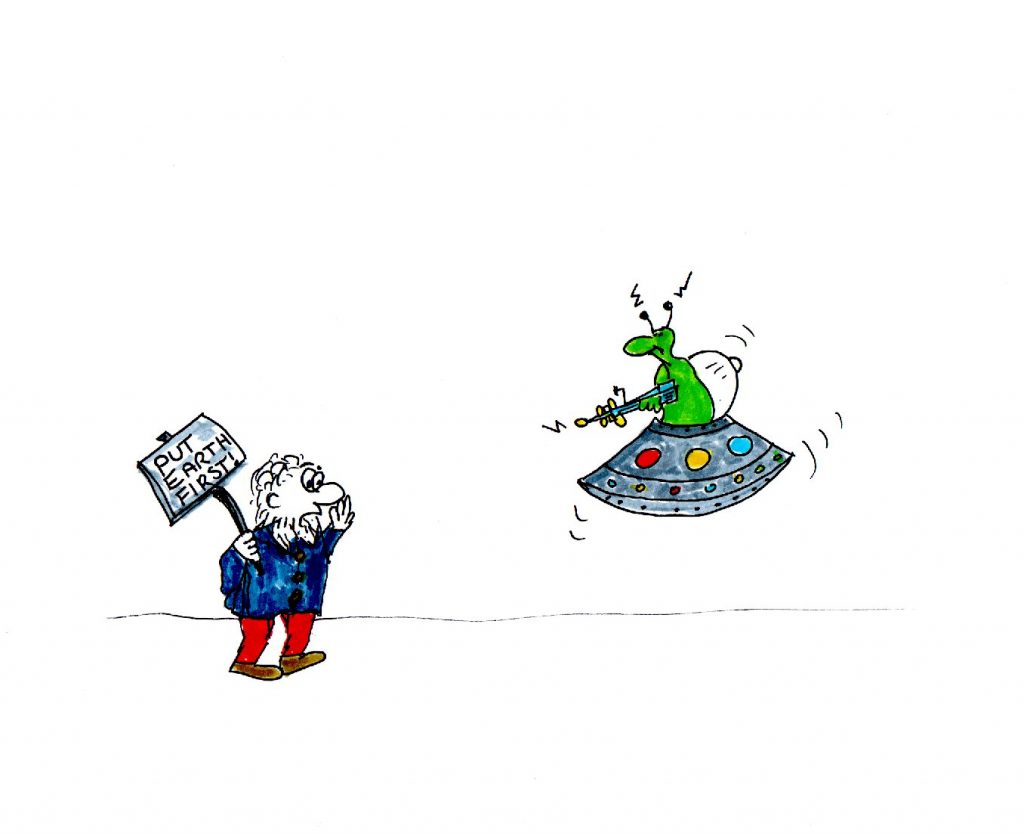Make-shift polling station
Bakery fakery!



Science making a white bread taste like brown…
Hybrid ‘Hybread’ Bakery, where a white loaf tastes like wholegrain.
Why not just waste even more time on nonsense science… what’s the point?

Soooooo good for the garden – but not so good for you!


“Can you explain democracy to me again please?”


“Do as I say, not as I do!”

On a linear scale, the size of a dust speck is nowhere near the midpoint between an atom and Earth. However, if we consider a logarithmic scale, which compares things in terms of orders of magnitude rather than absolute size, the idea becomes more meaningful.

While 30 grams is heavier than what we’d typically consider a speck of dust, it’s not too far off when we’re looking at the vast difference in scale between an atom and the Earth.
So, proportionally speaking, a speck of dust’s mass is closer to the midpoint on a logarithmic scale, even though it’s not exactly halfway.
It’s a way to visualize and understand the immense range of scales in our universe, from the very small to the very large. It’s not meant to be a precise measurement but rather an illustration of the concept of scale.

This is a problem for Japan as it has a growing elderly population. It means Japan has one older person for every three citizens. 33% of the population is elderly and not part of its workforce.
If this trend continues Japan is on course to lose around 40% of its workforce and that is a massive problem for Japan’s economy.
According to a survey conducted by Rakuten Insight in 2023, dogs were the most popular pets in Japan, followed by cats and fish.


.

Our nearest galaxy is the Milky Way and, in a year, it moves 17 billion kilometres from where it was one a year ago.
So, by virtue of this fact, we have never been in the same place twice. Earth moves with the Milky Way.
The Milky Way galaxy is moving through space at around 550km/s – now that’s fast!


Inflation is falling and getting closer to the 2% target


It’s true! Little Lego figures outnumber humans.
It is estimated that there are 8.1 billion humans on planet Earth and 10 billion little Lego mini characters.
So, humans are out numbered by Lego minifigures!
or
In the short scale system, which is commonly used in the UK, United States and most English-speaking countries, 1 billion is written as 1,000,000,000 or 109. This means that 1 billion is equal to 1 thousand million.
In the long scale system, which is commonly used in continental Europe and some other parts of the world, 1 billion is written as 1,000,000,000,000 or 1012. This means that 1 billion is equal to 1 million million.
If you tried to count to 1 million at an approximate rate of 1 number per second, it would take around 11 days. And that would be without sleeping or taking a rest in between the marathon quest. But if you were to count to 1 billion it would take you… wait for it… a cool 32 years!
But just imagine this, if you attempted to count to 1 trillion (1000,000,000,000) or 1012 at the same rate of 1 number per second and without sleep, rest or mistakes – it would take you about… 31,710 years! Give or take a year.
A million and 1 billion sound like BIG numbers, they are. But just how big…
Imagine this: 1 million seconds is roughly equal to 1 week. But, 1 billion seconds equates to about 33 years!
1 billion is a BIG number!
Apparently, the story goes that the most boring news day was 18th April 1930. Imagine turning on your radio ready to hear the news bulletin only to hear a BBC radio presenter announce, ‘There is no news!’
Can’t ever imagine that happening now – 24 hour news nonsense fills up all the gaps!
Well, it’s true.
The universe is so vast it is just mind bogglingly impossible to imagine how many atoms make it up. The estimated number of atoms in the universe is calculated at 10 to the power of 80 (1080).
But, the number of moves in a chess game is far greater coming in at a massive 10 to the power of 120 (10120).
This is known as the ‘Shannon number’.
So, there are more moves in a game of chess than there are atoms in the universe, as we know it Jim!

To the moon and back.

The phrase ‘throwing your toys out of the pram’ is a British idiom that means to behave in a childish or immature way when you are angry or frustrated. It is usually used to criticize someone who is acting unreasonably or making a fuss over something trivial.
Right now, it sums up everyday behaviour at No. 10 Downing Street.
This time of year, in December as it gets colder outside, the stock markets begin to warm-up.

